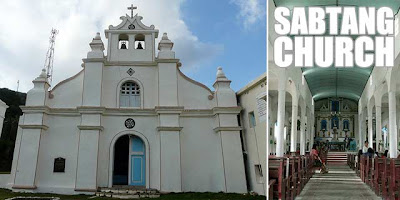 After two great days in Batanes, visiting Batan and Sabtang, we decided to take it easy on our last full day. Had the Itbayat Airport been open, we might have considered flying there. But the runway is still under repair. And the airport won't open until the summer months. The largest of Batanes’ three inhabited islands but the least-populated, Itbayat is the northernmost municipality of the Philippines.
After two great days in Batanes, visiting Batan and Sabtang, we decided to take it easy on our last full day. Had the Itbayat Airport been open, we might have considered flying there. But the runway is still under repair. And the airport won't open until the summer months. The largest of Batanes’ three inhabited islands but the least-populated, Itbayat is the northernmost municipality of the Philippines.Anyway, by the time we knew it, it was already time for lunch. We rented bicycles in the afternoon to explore Basco and its environs on our own. I had wanted to visit the burial sites north of Basco but we changed plans. Maybe for our next visit, we'll hire a van going there. So we just biked around town and the nearby viewpoints.
 For dinner, we made sure to visit Casa Napoli for some pizza. We had planned to have dinner there yesterday but it turns out they are closed on Sundays.
For dinner, we made sure to visit Casa Napoli for some pizza. We had planned to have dinner there yesterday but it turns out they are closed on Sundays. Don't miss out also on traditional Ivatan fare at Therese Coffee Shop which we discovered only the day before we left. We had lunes or Ivatan adobo there for breakfast before our flight back to Manila. It's best to call them in advance to prepare the food so that it's ready when you get there. You can contact them at (0916) 1142632 or (0921) 4040567. Some of the other interesting Batanes dishes are mixed Ivatan salad, venus, uvod balls, lobster and coconut crabs. But since we were in a rush, we could not try them all.
Don't miss out also on traditional Ivatan fare at Therese Coffee Shop which we discovered only the day before we left. We had lunes or Ivatan adobo there for breakfast before our flight back to Manila. It's best to call them in advance to prepare the food so that it's ready when you get there. You can contact them at (0916) 1142632 or (0921) 4040567. Some of the other interesting Batanes dishes are mixed Ivatan salad, venus, uvod balls, lobster and coconut crabs. But since we were in a rush, we could not try them all.Batanes is simply paradise undiscovered! Many have been asking me about hotels. So I've listed some below. Of course, for the high-end, I've mentioned Fundacion Pacita in a previous post. Remember that room rates vary depending on season and are generally higher during the summer months.
 And did I mention I saw the smiley in the sky that night?
And did I mention I saw the smiley in the sky that night?Batanes Resort
(0927) 5829078
Batanes Seaside Lodge & Restaurant
(0921) 2290120 / (0915) 9404823
Shanedel's Inn & Cafe
(02) 4130505 / (0920) 4470737
Part 1: Batanes, undiscovered paradise up north
Part 2: Marlboro Country, Mahatao Church and more from Batan Island
Part 3: Batanes stone houses in Savidug and Chavayan, Nakabuang Beach and more from Sabtang Island




















